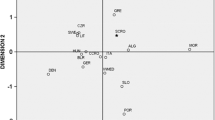Abstract
The X-chromosome short tandem repeat (STR) loci are of particular interest for solving complex kinship and paternity cases. Here, we report the genetic data from 209 unrelated Bangladeshi individuals (102 males and 107 females) that were genotyped using the 12 X-chromosomal STR markers included in the Investigator® Argus X-12 kit (Qiagen). The 12 X-STR markers are located in four linkage groups (linkage group I: DXS10135, DXS10148, and DXS8378; linkage group II: DXS7132, DXS10079, and DXS10074; linkage group III: DXS10103, HPRTB, and DXS10101; and linkage group IV: DXS10146, DXS10134, and DXS7423). Allelic frequencies of the 12 X-STR loci and haplotype frequencies of the four linkage groups were investigated. No significant difference was observed in the allele frequencies of males and females. Distributions of heterozygosity were observed from 64.5 to 92.5% among the studied 12 X STR loci. DXS10135 and DXS10101 loci were found to be most polymorphic. For all the four linkage groups, the haplotype diversity was found to be greater than 0.986. A total of 95, 73, 66, and 74 haplotypes were observed in linkage groups I, II, III, and IV, respectively. Hardy–Weinberg equilibrium tests showed no significant deviation from expected values for all 12 loci (p > 0.05). The exact test for pairwise linkage disequilibrium for the 12 loci in the male samples did not show any significant linkage disequilibrium except the DXS10103 and DXS10101 loci after the p values were corrected by Bonferroni’s correction for multiple testing (p > 0.05/66). A combined power of discrimination in male and female individuals were 0.999999998159791 and 0.999999999999993, respectively. The combined mean exclusion chance were 0.999997635 in deficiency cases, 0.999999996 in normal trio cases, and 0.999999178 in duo cases. The currently investigated Bangladeshi population showed significant differences when compared with previously reported X-STR data from other 12 populations. The results of the data analysis indicated that all the loci in the Investigator® Argus X 12 kit were fairly informative and might be useful in forensic application and kinship analysis in Bangladeshi population.
Similar content being viewed by others
References
Dumache R et al (2016) Molecular DNA analysis in forensic identification. Clin Lab 62(1–2):245–248
Hossain T et al (2014) Population genetic data on 15 autosomal STR loci in Bangladeshi population. Forensic Sci Int Genet 13:e4–e5
Liu QL et al (2012) Development and population study of the 12 X-STR loci multiplexes PCR systems. Int J Legal Med 126(4):665–670
Trindade-Filho A, Ferreira S, Oliveira SF (2013) Impact of a chromosome X STR Decaplex in deficiency paternity cases. Genet Mol Biol 36(4):507–510
Szibor R et al (2003) Use of X-linked markers for forensic purposes. Int J Legal Med 117(2):67–74
Walsh PS, Metzger DA, Higushi R (2013) Chelex 100 as a medium for simple extraction of DNA for PCR-based typing from forensic material. BioTechniques 54(3):134–139 BioTechniques 10(4): 506-13 (April 1991)
Gusmao L et al (2006) DNA Commission of the International Society of Forensic Genetics (ISFG): an update of the recommendations on the use of Y-STRs in forensic analysis. Int J Legal Med 120(4):191–200
Excoffier L, Lischer HE (2010) Arlequin suite ver 3.5: a new series of programs to perform population genetics analyses under Linux and Windows. Mol Ecol Resour 10(3):564–567
Takezaki N, Nei M, Tamura K (2010) POPTREE2: software for constructing population trees from allele frequency data and computing other population statistics with Windows interface. Mol Biol Evol 27(4):747–752
Acknowledgements
This study was supported by the Multi-Sectoral Program on Violence Against Women, Ministry of Women and Children Affairs, Government of the People’s Republic of Bangladesh.
Author information
Authors and Affiliations
Corresponding author
Ethics declarations
The procedures done in this study were in accordance with the Helsinki Declaration of 1964, revised in 1983.
Electronic supplementary material
ESM 1
(DOCX 92 kb)
Rights and permissions
About this article
Cite this article
Sufian, A., Hosen, M.I., Fatema, K. et al. Genetic diversity study on 12 X-STR loci of investigator® Argus X STR kit in Bangladeshi population. Int J Legal Med 131, 963–965 (2017). https://doi.org/10.1007/s00414-016-1513-2
Received:
Accepted:
Published:
Issue Date:
DOI: https://doi.org/10.1007/s00414-016-1513-2




